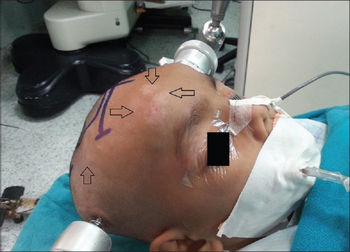Atonic seizure
| Atonic seizure | |
|---|---|
| Other names: Akinetic seizure, astatic seizure | |
 | |
| Multiple recurrent injuries on head following drop attacks | |
An atonic seizure (also called drop seizure, akinetic seizure, astatic seizure, or drop attack) is a type of seizure that consists of partial or complete loss of muscle tone that is caused by temporary alterations in brain function. These seizures are brief – usually less than fifteen seconds. They usually begin in childhood and may persist into adulthood. The seizure itself causes no physical injury, but the loss of control, predominantly in trunk muscles, can result in direct injury from falling. Electroencephalography can be used to confirm diagnosis. It is rare and can be indicative of Lennox–Gastaut syndrome (see Henri Gastaut).
Atonic seizures can occur while standing, walking, or sitting, and are often noticeable by a head drop (relaxing of the neck muscles). Fall injuries may result in impact to the face or head. As with common epileptic occurrences, no first aid is needed post-seizure, except in the instances where falling injuries have occurred. In some cases, a person may become temporarily paralyzed in part of his or her body. This usually does not last longer than 3 minutes.[1][citation needed]
There is no general treatment for patients with a seizure disorder. Each treatment plan is specifically tailored to the individual patient based on their diagnosis and symptoms. Treatment options may include medical therapy, nerve stimulation, dietary therapy, or surgery, as appropriate. Clinical trials may also be a valuable treatment alternative. Usually, anticonvulsants are given based on other symptoms and / or associated problems. Because the areas of the cerebellum which determine increases and decreases in muscle tone are close together, people experiencing atonic seizures are most likely experiencing myoclonic ones too, at some point. This may play a role in therapy and diagnostic.[2]One surgical approach, selective posterior callostomy, can greatly decrease instances of drop attacks and improve function and behavior in patients with intellectual disability.[3]
References
- ↑ "Atonic Seizures". Epilepsy Foundation. Archived from the original on 2019-03-30. Retrieved 2019-09-13.
- ↑ "Atonic Seizure - Types of Seizures - The Johns Hopkins Epilepsy Center". Archived from the original on 2012-08-16. Retrieved 2012-08-18.
- ↑ Paglioli, Eliseu; Martins, William Alves; Azambuja, Ney; Portuguez, Mirna; Frigeri, Thomas More; Pinos, Larissa; Saute, Ricardo; Salles, Cora; Hoefel, João Rubião (2016-11-08). "Selective posterior callosotomy for drop attacks: A new approach sparing prefrontal connectivity". Neurology. 87 (19): 1968–1974. doi:10.1212/WNL.0000000000003307. ISSN 1526-632X. PMID 27733569. S2CID 24541945.
External links
| Classification |
|---|